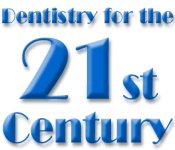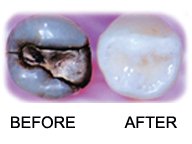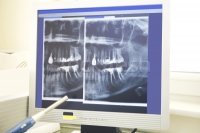|
what's new in dentistry
by Richard T. Hansen, DMD, FACAD Director, Laser Dental Wellness Center-Fullerton  Patients today are increasingly taking more responsibility for their own health care. They tend to be well-read, educated by previous health-care experiences, and much more discriminating in their own choice of practitioners and treatment methods. As health practitioners struggling with the complex task of helping these patients achieve optimum wellness, we are constantly searching for the information that best answers their questions and offers solutions to their health concerns. Patients today are increasingly taking more responsibility for their own health care. They tend to be well-read, educated by previous health-care experiences, and much more discriminating in their own choice of practitioners and treatment methods. As health practitioners struggling with the complex task of helping these patients achieve optimum wellness, we are constantly searching for the information that best answers their questions and offers solutions to their health concerns.Our task is complicated by genetics, the environment, nutrition, emotional and personal habits that compromise and influence our patients' health. These influences include the subtle but powerful adverse effects of dental materials and procedures on the body. If we look at the optimum wellness and longevity as a complex picture composed of many puzzle pieces, we find a multitude of influences on our health. Each of these pieces needs to be balanced with the specific needs of the individual in order to ensure as long a life as possible free of disease. We begin our journey in life with certain genetic weaknesses and predispositions toward the breakdown of one biological system or another. But researchers are coming to appreciate that disease once attributed to the inevitability of genetics and age can actually be avoided by proper care of the body and the mind. Our bodies have the ability to overcome their inherent system weaknesses if the entire system is maintained at its peak performance level, enabling it to repair itself upon injury and resist the countless negative influences that attack it daily. what's new in dentistry In determining the patient's unique needs, it is becoming increasingly important for the dentist to work with other cutting-edge, integrative practitioners to fully assess the individual requirements of the patient before, during, and after dental care. We have been fortunate to have worked with many physicians, chiropractors, acupuncturists, nutritionists, ayurvedics and other advanced health care practitioners not only for this purpose, but for investigating and developing better methods of delivering advanced dental care - dental care that not only focuses on disease within the mouth, but recognizes the integral role optimum oral health plays in the overall long-term health of the body. We are learning how important it is to save as much of the natural tooth structure as possible; and with the materials and procedures now available, much more of it can be preserved than has ever been possible before. what's new in dentistry In the past, dentists did not think about dental materials and treatments as they related to the whole body, and they were limited by the materials and techniques available. Today, much more is known about the subtle interactions between the teeth and the whole body system, and the negative effects of many materials, techniques, and therapies dental professionals have used for decades without a second thought. We have learned about the systemic effects of localized foci of infection; the fact that placement of metal and alloy fillings can weaken the tooth so that future, more invasive dentistry becomes necessary; the leaking of mercury into the body tissues from dental amalgam fillings (now known to occur at the alarming rate of 3 to 17 micrograms per day); the relation of the tooth and jaw position to the natural balance of the human system; the electric current generated and the corrosive effects of having mixed-metals present in the oral environment. Health practitioners using advanced screening methods have concluded that tooth-colored composites containing petroleum products, metal oxides, aluminum, petrochemicals or bis-phenols may be worse for long-term health than the mercury alloys they are replacing. what's new in dentistry The traditional style of dentistry has been to treat early, small cavities in children and adults with silver/mercury alloy fillings that necessitated drilling large amounts of good tooth structure just to wedge the filling into the tooth to make it stay in place. These fillings profoundly weakened the tooth thereby setting it up for additional decay, fracture, corrosion, and breakage. This invariably leads to much larger fillings, crowns, and in many cases, root canals. The new advanced style of dentistry is to preserve as much tooth structure as possible, fill the teeth early with biocompatible materials, and structurally reinforce teeth to prevent further problems. what's new in dentistry Until now, most dentists have been reluctant to change materials and techniques because the alternatives to traditional dental therapy were not adequate. But research and development during the last ten years have produced dental materials that are not only more biologically compatible than the traditional dental amalgam, but are also stronger and can actually reinforce the tooth internally, thereby preventing further damage and need for future dentistry. There are now over one hundred different ceramic, glass-ceramic, and ceramic polymers that are superior to the older restorative materials in terms of both strength and function. In addition, we can now treat small decayed areas with a pin-point laser or air-particle beam, inject a tooth-replacement, and fuse the material with a laser to the tooth. These techniques not only preserve the strength and beauty of the tooth, but may keep the tooth from needing future, more destructive dentistry. By using these techniques early on, we may be able to eliminate the need for most root canals and crowns; maybe even eliminate the need for most adult dentistry altogether. After all, the best dentistry would be not to need any dentistry at all. what's new in dentistry Research has been proceeding so rapidly, however, that most dental practitioners , even those who practice more biologically-oriented dentistry, do not understand the properties and proper placement techniques required for using these more advanced materials. There is no widely available educational source where dental practitioners can learn the precise indications of materials selection and the technique-sensitive restorative methods unique to each patients' needs. The Center for Advanced Dentistry, an Educational Institution, also registered with the Board of Dental Examiners in Sacramento, was created to respond to this problem. With the help of the Advanced Health Research Institute, we are compiling research, educational materials and faculty to provide practitioners in all fields of healthcare with the most up-to-date information necessary to better serve patients. The Center for Advanced Dentistry will also provide a program to help educate and train dental professionals, their staff, and interested healthcare professionals on advanced dentistry as it relates to total patient care. Professionals who have completed advanced training become members of the Comprehensive Health Association. This provides a vehicle for continuing the process of education, keeping up with future advances, and to contribute ideas, thoughts, and research toward advanced, future dentistry so that all may benefit. what's new in dentistry We are propelled by a strong sense of urgency and mission in publicizing both the new methods and techniques, and the little-appreciated hazards of the conventional alternatives. Dentists are still grinding perfectly viable teeth down to "pegs" and placing potentially toxic metal crowns on them, when techniques are now available for repairing the damaged part of the tooth with wholly biocompatible materials, leaving the bulk of the natural tooth intact. Dentists are still placing huge amalgam "plugs" in the center of viable teeth, wedging the cusps apart and leading to inevitable leakage and breakage, when techniques are now available for placing materials that not only do not force the cusps apart, but weld them together, strengthening rather than weakening the tooth. what's new in dentistry Besides researching the latest in dental materials and techniques to provide viable alternatives to traditional dental care, one of the primary goals of our facility is advancement of our profession through education. Our center also provides information on advanced dentistry to interested professionals and others on request. what's new in dentistry If you have any questions regarding any of these topics, you may call our facility at 714-870-0310, or E-Mail us. what's new in dentistry Top of Page Return from "What's New in Dentistry" to Home Page |


A better, more comfortable and healthier way to fill teeth!

CLICK HERE to find out about our Laser Nerve Treatment, a way to avoid root canals!